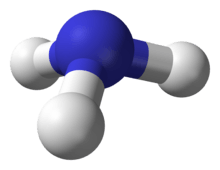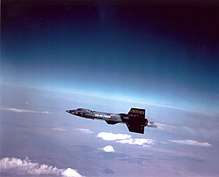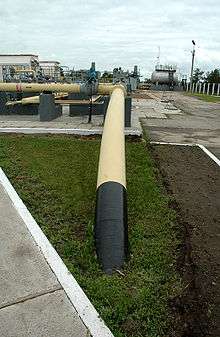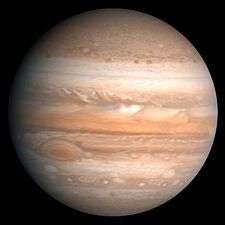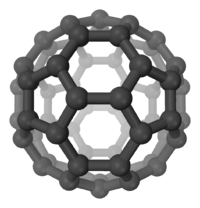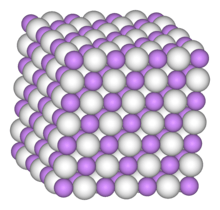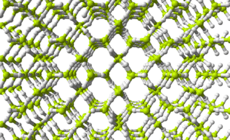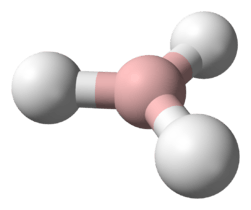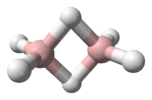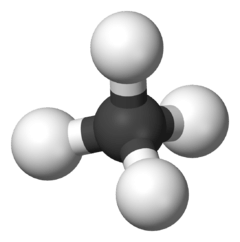Ammonia
Ammonia is a compound of nitrogen and hydrogen with the formula NH3. A stable binary hydride, and the simplest pnictogen hydride, ammonia is a colourless gas with a characteristic pungent smell. It is a common nitrogenous waste, particularly among aquatic organisms, and it contributes significantly to the nutritional needs of terrestrial organisms by serving as a precursor to food and fertilizers. Ammonia, either directly or indirectly, is also a building block for the synthesis of many pharmaceutical products and is used in many commercial cleaning products. It is mainly collected by downward displacement of both air and water.
 | |||
| |||
| Names | |||
|---|---|---|---|
| IUPAC names | |||
| Other names
Azane (only intended for use in naming derivatives of ammonia) Hydrogen nitride | |||
| Identifiers | |||
3D model (JSmol) |
|||
| 3DMet | |||
| 3587154 | |||
| ChEBI | |||
| ChEMBL | |||
| ChemSpider | |||
| ECHA InfoCard | 100.028.760 | ||
| EC Number |
| ||
| 79 | |||
| KEGG | |||
| MeSH | Ammonia | ||
PubChem CID |
|||
| RTECS number |
| ||
| UNII | |||
| UN number | 1005 | ||
CompTox Dashboard (EPA) |
|||
| |||
| |||
| Properties | |||
| NH3 | |||
| Molar mass | 17.031 g/mol | ||
| Appearance | Colourless gas | ||
| Odor | strong pungent odour | ||
| Density | 0.86 kg/m3 (1.013 bar at boiling point) 0.769 kg/m3 (STP)[2] | ||
| Melting point | −77.73 °C (−107.91 °F; 195.42 K) (Triple point at 6.060 kPa, 195.4 K) | ||
| Boiling point | −33.34 °C (−28.01 °F; 239.81 K) | ||
| Critical point (T, P) | 132.4 °C (405.5 K), 111.3 atm (11,280 kPa) | ||
| 47% w/w (0 °C) 31% w/w (25 °C) 18% w/w (50 °C)[5] | |||
| Solubility | soluble in chloroform, ether, ethanol, methanol | ||
| Vapor pressure | 857.3 kPa | ||
| Acidity (pKa) | 32.5 (−33 °C),[6] 10.5 (DMSO) | ||
| Basicity (pKb) | 4.75 | ||
| Conjugate acid | Ammonium | ||
| Conjugate base | Azanide | ||
| −18.0·10−6 cm3/mol | |||
Refractive index (nD) |
1.3327 | ||
| Viscosity |
| ||
| Structure | |||
| C3v | |||
| Trigonal pyramid | |||
| 1.42 D | |||
| Thermochemistry | |||
Std molar entropy (S |
193 J·mol−1·K−1[8] | ||
Std enthalpy of formation (ΔfH⦵298) |
−46 kJ·mol−1[8] | ||
| Hazards | |||
| Safety data sheet | See: data page ICSC 0414 (anhydrous) | ||
| GHS pictograms |    | ||
| GHS Signal word | Danger | ||
GHS hazard statements |
H290, H301, H311, H314, H330, H334, H336, H360, H362, H373, H400 | ||
| P202, P221, P233, P261, P263, P271, P273, P280, P305+351+338, P310[9] | |||
| NFPA 704 (fire diamond) | |||
| Flash point | 132 | ||
| 651 °C (1,204 °F; 924 K) | |||
| Explosive limits | 15–28% | ||
| Lethal dose or concentration (LD, LC): | |||
LD50 (median dose) |
0.015 mL/kg (human, oral) | ||
LC50 (median concentration) |
40,300 ppm (rat, 10 min) 28,595 ppm (rat, 20 min) 20,300 ppm (rat, 40 min) 11,590 ppm (rat, 1 hr) 7338 ppm (rat, 1 hr) 4837 ppm (mouse, 1 hr) 9859 ppm (rabbit, 1 hr) 9859 ppm (cat, 1 hr) 2000 ppm (rat, 4 hr) 4230 ppm (mouse, 1 hr)[10] | ||
LCLo (lowest published) |
5000 ppm (mammal, 5 min) 5000 ppm (human, 5 min)[10] | ||
| NIOSH (US health exposure limits):[11] | |||
PEL (Permissible) |
50 ppm (25 ppm ACGIH- TLV; 35 ppm STEL) | ||
REL (Recommended) |
TWA 25 ppm (18 mg/m3) ST 35 ppm (27 mg/m3) | ||
IDLH (Immediate danger) |
300 ppm | ||
| Related compounds | |||
Other cations |
Phosphine Arsine Stibine Bismuthine | ||
Related nitrogen hydrides |
Hydrazine Hydrazoic acid | ||
Related compounds |
Ammonium hydroxide | ||
| Supplementary data page | |||
| Refractive index (n), Dielectric constant (εr), etc. | |||
Thermodynamic data |
Phase behaviour solid–liquid–gas | ||
| UV, IR, NMR, MS | |||
Except where otherwise noted, data are given for materials in their standard state (at 25 °C [77 °F], 100 kPa). | |||
| Infobox references | |||
Although common in nature—both terrestrially and in the outer planets of the Solar System—and in wide use, ammonia is both caustic and hazardous in its concentrated form. It is classified as an extremely hazardous substance in the United States, and is subject to strict reporting requirements by facilities which produce, store, or use it in significant quantities.[12]
The global industrial production of ammonia in 2018 was 175 million tonnes,[13] with no significant change relative to the 2013 global industrial production of 175 million tonnes.[14] Industrial ammonia is sold either as ammonia liquor (usually 28% ammonia in water) or as pressurized or refrigerated anhydrous liquid ammonia transported in tank cars or cylinders.[15]
NH3 boils at −33.34 °C (−28.012 °F) at a pressure of one atmosphere, so the liquid must be stored under pressure or at low temperature. Household ammonia or ammonium hydroxide is a solution of NH3 in water. The concentration of such solutions is measured in units of the Baumé scale (density), with 26 degrees Baumé (about 30% (by weight) ammonia at 15.5 °C or 59.9 °F) being the typical high-concentration commercial product.[16]
Etymology
Pliny, in Book XXXI of his Natural History, refers to a salt produced in the Roman province of Cyrenaica named hammoniacum, so called because of its proximity to the nearby Temple of Jupiter Amun (Greek Ἄμμων Ammon).[17] However, the description Pliny gives of the salt does not conform to the properties of ammonium chloride. According to Herbert Hoover's commentary in his English translation of Georgius Agricola's De re metallica, it is likely to have been common sea salt.[18] In any case, that salt ultimately gave ammonia and ammonium compounds their name.
Natural occurrence
Ammonia is a chemical found in trace quantities in nature, being produced from nitrogenous animal and vegetable matter. Ammonia and ammonium salts are also found in small quantities in rainwater, whereas ammonium chloride (sal ammoniac), and ammonium sulfate are found in volcanic districts; crystals of ammonium bicarbonate have been found in Patagonia guano.[19] The kidneys secrete ammonia to neutralize excess acid.[20] Ammonium salts are found distributed through fertile soil and in seawater.
Ammonia is also found throughout the Solar System on Mars, Jupiter, Saturn, Uranus, Neptune, and Pluto, among other places: on smaller, icy bodies such as Pluto, ammonia can act as a geologically important antifreeze, as a mixture of water and ammonia can have a melting point as low as 173 K (−100 °C; −148 °F) if the ammonia concentration is high enough and thus allow such bodies to retain internal oceans and active geology at a far lower temperature than would be possible with water alone.[21][22] Substances containing ammonia, or those that are similar to it, are called ammoniacal.
Properties
Ammonia is a colourless gas with a characteristically pungent smell. It is lighter than air, its density being 0.589 times that of air. It is easily liquefied due to the strong hydrogen bonding between molecules; the liquid boils at −33.3 °C (−27.94 °F), and freezes to white crystals[19] at −77.7 °C (−107.86 °F).
Ammonia may be conveniently deodorized by reacting it with either sodium bicarbonate or acetic acid. Both of these reactions form an odourless ammonium salt.
- Solid
- The crystal symmetry is cubic, Pearson symbol cP16, space group P213 No.198, lattice constant 0.5125 nm.[23]
- Liquid
- Liquid ammonia possesses strong ionising powers reflecting its high ε of 22. Liquid ammonia has a very high standard enthalpy change of vaporization (23.35 kJ/mol, cf. water 40.65 kJ/mol, methane 8.19 kJ/mol, phosphine 14.6 kJ/mol) and can therefore be used in laboratories in uninsulated vessels without additional refrigeration. See liquid ammonia as a solvent.
- Solvent properties
- Ammonia readily dissolves in water. In an aqueous solution, it can be expelled by boiling. The aqueous solution of ammonia is basic. The maximum concentration of ammonia in water (a saturated solution) has a density of 0.880 g/cm3 and is often known as '.880 ammonia'.
- Combustion
- Ammonia does not burn readily or sustain combustion, except under narrow fuel-to-air mixtures of 15–25% air. When mixed with oxygen, it burns with a pale yellowish-green flame. At high temperature and in the presence of a suitable catalyst, ammonia is decomposed into its constituent elements. Ignition occurs when chlorine is passed into ammonia, forming nitrogen and hydrogen chloride; if chlorine is present in excess, then the highly explosive nitrogen trichloride (NCl3) is also formed.
Structure
The ammonia molecule has a trigonal pyramidal shape as predicted by the valence shell electron pair repulsion theory (VSEPR theory) with an experimentally determined bond angle of 106.7°.[24] The central nitrogen atom has five outer electrons with an additional electron from each hydrogen atom. This gives a total of eight electrons, or four electron pairs that are arranged tetrahedrally. Three of these electron pairs are used as bond pairs, which leaves one lone pair of electrons. The lone pair repels more strongly than bond pairs, therefore the bond angle is not 109.5°, as expected for a regular tetrahedral arrangement, but 106.7°.[24] This shape gives the molecule a dipole moment and makes it polar. The molecule's polarity, and especially, its ability to form hydrogen bonds, makes ammonia highly miscible with water. The lone pair makes ammonia a base, a proton acceptor. Ammonia is moderately basic; a 1.0 M aqueous solution has a pH of 11.6, and if a strong acid is added to such a solution until the solution is neutral (pH = 7), 99.4% of the ammonia molecules are protonated. Temperature and salinity also affect the proportion of NH4+. The latter has the shape of a regular tetrahedron and is isoelectronic with methane.
The ammonia molecule readily undergoes nitrogen inversion at room temperature; a useful analogy is an umbrella turning itself inside out in a strong wind. The energy barrier to this inversion is 24.7 kJ/mol, and the resonance frequency is 23.79 GHz, corresponding to microwave radiation of a wavelength of 1.260 cm. The absorption at this frequency was the first microwave spectrum to be observed.[25]
Amphotericity
One of the most characteristic properties of ammonia is its basicity. Ammonia is considered to be a weak base. It combines with acids to form salts; thus with hydrochloric acid it forms ammonium chloride (sal ammoniac); with nitric acid, ammonium nitrate, etc. Perfectly dry ammonia will not combine with perfectly dry hydrogen chloride; moisture is necessary to bring about the reaction.[26][27] As a demonstration experiment, opened bottles of concentrated ammonia and hydrochloric acid produce clouds of ammonium chloride, which seem to appear "out of nothing" as the salt forms where the two diffusing clouds of molecules meet, somewhere between the two bottles.
The salts produced by the action of ammonia on acids are known as the ammonium salts and all contain the ammonium ion (NH4+).[26]
Although ammonia is well known as a weak base, it can also act as an extremely weak acid. It is a protic substance and is capable of formation of amides (which contain the NH2− ion). For example, lithium dissolves in liquid ammonia to give a solution of lithium amide:
Self-dissociation
Like water, ammonia undergoes molecular autoionisation to form its acid and base conjugates:
Ammonia often functions as a weak base, so it has some buffering ability. Shifts in pH will cause more or fewer ammonium cations (NH+
4) and amide anions (NH−
2) to be present in solution. At standard pressure and temperature, K=[NH+
4][NH−
2] = 10−30
Combustion
The combustion of ammonia to nitrogen and water is exothermic:
The standard enthalpy change of combustion, ΔH°c, expressed per mole of ammonia and with condensation of the water formed, is −382.81 kJ/mol. Dinitrogen is the thermodynamic product of combustion: all nitrogen oxides are unstable with respect to N2 and O2, which is the principle behind the catalytic converter. Nitrogen oxides can be formed as kinetic products in the presence of appropriate catalysts, a reaction of great industrial importance in the production of nitric acid:
A subsequent reaction leads to NO2:
The combustion of ammonia in air is very difficult in the absence of a catalyst (such as platinum gauze or warm chromium(III) oxide), due to the relatively low heat of combustion, a lower laminar burning velocity, high auto-ignition temperature, high heat of vaporization, and a narrow flammability range. However, recent studies have shown that efficient and stable combustion of ammonia can be achieved using swirl combustors, thereby rekindling research interest in ammonia as a fuel for thermal power production.[28] The flammable range of ammonia in dry air is 15.15%-27.35% and in 100% relative humidity air is 15.95%-26.55%.[29] For studying the kinetics of ammonia combustion a detailed reliable reaction mechanism is required, however knowledge about ammonia chemical kinetics during combustion process has been challenging.[30]
Formation of other compounds
In organic chemistry, ammonia can act as a nucleophile in substitution reactions. Amines can be formed by the reaction of ammonia with alkyl halides, although the resulting -NH2 group is also nucleophilic and secondary and tertiary amines are often formed as byproducts. An excess of ammonia helps minimise multiple substitution and neutralises the hydrogen halide formed. Methylamine is prepared commercially by the reaction of ammonia with chloromethane, and the reaction of ammonia with 2-bromopropanoic acid has been used to prepare racemic alanine in 70% yield. Ethanolamine is prepared by a ring-opening reaction with ethylene oxide: the reaction is sometimes allowed to go further to produce diethanolamine and triethanolamine.
Amides can be prepared by the reaction of ammonia with carboxylic acid derivatives. Acyl chlorides are the most reactive, but the ammonia must be present in at least a twofold excess to neutralise the hydrogen chloride formed. Esters and anhydrides also react with ammonia to form amides. Ammonium salts of carboxylic acids can be dehydrated to amides so long as there are no thermally sensitive groups present: temperatures of 150–200 °C are required.
The hydrogen in ammonia is susceptible to replacement by myriad substituents. When heated with sodium it converts to sodamide, NaNH2.[26] With chlorine, monochloramine is formed.
Pentavalent ammonia is known as λ5-amine or, more commonly, ammonium hydride. This crystalline solid is only stable under high pressure and decomposes back into trivalent ammonia and hydrogen gas at normal conditions. This substance was once investigated as a possible solid rocket fuel in 1966.[31]
Ammonia as a ligand
-3D-balls.png)
Ammonia can act as a ligand in transition metal complexes. It is a pure σ-donor, in the middle of the spectrochemical series, and shows intermediate hard-soft behaviour (see also ECW model). For historical reasons, ammonia is named ammine in the nomenclature of coordination compounds. Some notable ammine complexes include tetraamminediaquacopper(II) ([Cu(NH3)4(H2O)2]2+), a dark blue complex formed by adding ammonia to a solution of copper(II) salts. Tetraamminediaquacopper(II) hydroxide is known as Schweizer's reagent, and has the remarkable ability to dissolve cellulose. Diamminesilver(I) ([Ag(NH3)2]+) is the active species in Tollens' reagent. Formation of this complex can also help to distinguish between precipitates of the different silver halides: silver chloride (AgCl) is soluble in dilute (2M) ammonia solution, silver bromide (AgBr) is only soluble in concentrated ammonia solution, whereas silver iodide (AgI) is insoluble in aqueous ammonia.
Ammine complexes of chromium(III) were known in the late 19th century, and formed the basis of Alfred Werner's revolutionary theory on the structure of coordination compounds. Werner noted only two isomers (fac- and mer-) of the complex [CrCl3(NH3)3] could be formed, and concluded the ligands must be arranged around the metal ion at the vertices of an octahedron. This proposal has since been confirmed by X-ray crystallography.
An ammine ligand bound to a metal ion is markedly more acidic than a free ammonia molecule, although deprotonation in aqueous solution is still rare. One example is the Calomel reaction, where the resulting amidomercury(II) compound is highly insoluble.
Detection and determination
Ammonia in solution
Ammonia and ammonium salts can be readily detected, in very minute traces, by the addition of Nessler's solution, which gives a distinct yellow colouration in the presence of the slightest trace of ammonia or ammonium salts. The amount of ammonia in ammonium salts can be estimated quantitatively by distillation of the salts with sodium or potassium hydroxide, the ammonia evolved being absorbed in a known volume of standard sulfuric acid and the excess of acid then determined volumetrically; or the ammonia may be absorbed in hydrochloric acid and the ammonium chloride so formed precipitated as ammonium hexachloroplatinate, (NH4)2PtCl6.[32]
Gaseous ammonia
Sulfur sticks are burnt to detect small leaks in industrial ammonia refrigeration systems. Larger quantities can be detected by warming the salts with a caustic alkali or with quicklime, when the characteristic smell of ammonia will be at once apparent.[32] Ammonia is an irritant and irritation increases with concentration; the permissible exposure limit is 25 ppm, and lethal above 500 ppm.[33] Higher concentrations are hardly detected by conventional detectors, the type of detector is chosen according to the sensitivity required (e.g. semiconductor, catalytic, electrochemical). Holographic sensors have been proposed for detecting concentrations up to 12.5% in volume.[34]
Ammoniacal nitrogen (NH3-N)
Ammoniacal nitrogen (NH3-N) is a measure commonly used for testing the quantity of ammonium ions, derived naturally from ammonia, and returned to ammonia via organic processes, in water or waste liquids. It is a measure used mainly for quantifying values in waste treatment and water purification systems, as well as a measure of the health of natural and man-made water reserves. It is measured in units of mg/L (milligram per litre).
History
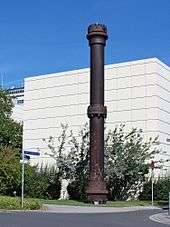
The ancient Greek historian Herodotus mentioned that there were outcrops of salt in an area of Libya that was inhabited by a people called the "Ammonians" (now: the Siwa oasis in northwestern Egypt, where salt lakes still exist).[35][36] The Greek geographer Strabo also mentioned the salt from this region. However, the ancient authors Dioscorides, Apicius, Arrian, Synesius, and Aëtius of Amida described this salt as forming clear crystals that could be used for cooking and that were essentially rock salt.[37] Hammoniacus sal appears in the writings of Pliny,[38] although it is not known whether the term is identical with the more modern sal ammoniac (ammonium chloride).[19][39][40]
The fermentation of urine by bacteria produces a solution of ammonia; hence fermented urine was used in Classical Antiquity to wash cloth and clothing, to remove hair from hides in preparation for tanning, to serve as a mordant in dying cloth, and to remove rust from iron.[41]
In the form of sal ammoniac (نشادر, nushadir), ammonia was important to the Muslim alchemists as early as the 8th century, first mentioned by the Persian-Arab chemist Jābir ibn Hayyān,[42] and to the European alchemists since the 13th century, being mentioned by Albertus Magnus.[19] It was also used by dyers in the Middle Ages in the form of fermented urine to alter the colour of vegetable dyes. In the 15th century, Basilius Valentinus showed that ammonia could be obtained by the action of alkalis on sal ammoniac.[43] At a later period, when sal ammoniac was obtained by distilling the hooves and horns of oxen and neutralizing the resulting carbonate with hydrochloric acid, the name "spirit of hartshorn" was applied to ammonia.[19][44]
Gaseous ammonia was first isolated by Joseph Black in 1756 by reacting sal ammoniac (Ammonium Chloride) with calcined magnesia (Magnesium Oxide).[45][46] It was isolated again by Peter Woulfe in 1767,[47][48] by Carl Wilhelm Scheele in 1770[49] and by Joseph Priestley in 1773 and was termed by him "alkaline air".[19][50] Eleven years later in 1785, Claude Louis Berthollet ascertained its composition.[51][19]
The Haber–Bosch process to produce ammonia from the nitrogen in the air was developed by Fritz Haber and Carl Bosch in 1909 and patented in 1910. It was first used on an industrial scale in Germany during World War I,[52] following the allied blockade that cut off the supply of nitrates from Chile. The ammonia was used to produce explosives to sustain war efforts.[53]
Before the availability of natural gas, hydrogen as a precursor to ammonia production was produced via the electrolysis of water or using the chloralkali process.
With the advent of the steel industry in the 20th century, ammonia became a byproduct of the production of coking coal.
Uses
Fertilizer
In the US as of 2019, approximately 88% of ammonia was used as fertilizers either as its salts, solutions or anhydrously.[13] When applied to soil, it helps provide increased yields of crops such as maize and wheat.[54] 30% of agricultural nitrogen applied in the US is in the form of anhydrous ammonia and worldwide 110 million tonnes are applied each year.[55]
Precursor to nitrogenous compounds
Ammonia is directly or indirectly the precursor to most nitrogen-containing compounds. Virtually all synthetic nitrogen compounds are derived from ammonia. An important derivative is nitric acid. This key material is generated via the Ostwald process by oxidation of ammonia with air over a platinum catalyst at 700–850 °C (1,292–1,562 °F), ≈9 atm. Nitric oxide is an intermediate in this conversion:[56]
Nitric acid is used for the production of fertilizers, explosives, and many organonitrogen compounds.
Ammonia is also used to make the following compounds:
- Hydrazine, in the Olin Raschig process and the peroxide process
- Hydrogen cyanide, in the BMA process and the Andrussow process
- Hydroxylamine and ammonium carbonate, in the Raschig process
- Phenol, in the Raschig–Hooker process
- Urea, in the Bosch–Meiser urea process and in Wöhler synthesis
- Amino acids, using Strecker amino-acid synthesis
- Acrylonitrile, in the Sohio process
Ammonia can also be used to make compounds in reactions which are not specifically named. Examples of such compounds include: ammonium perchlorate, ammonium nitrate, formamide, dinitrogen tetroxide, alprazolam, ethanolamine, ethyl carbamate, hexamethylenetetramine, and ammonium bicarbonate.
As a cleaner
Household ammonia is a solution of NH3 in water, and is used as a general purpose cleaner for many surfaces. Because ammonia results in a relatively streak-free shine, one of its most common uses is to clean glass, porcelain and stainless steel. It is also frequently used for cleaning ovens and soaking items to loosen baked-on grime. Household ammonia ranges in concentration by weight from 5 to 10% ammonia.[57] United States manufacturers of cleaning products are required to provide the product's material safety data sheet which lists the concentration used.[58]
Fermentation
Solutions of ammonia ranging from 16% to 25% are used in the fermentation industry as a source of nitrogen for microorganisms and to adjust pH during fermentation.
Antimicrobial agent for food products
As early as in 1895, it was known that ammonia was "strongly antiseptic ... it requires 1.4 grams per litre to preserve beef tea."[59] In one study, anhydrous ammonia destroyed 99.999% of zoonotic bacteria in 3 types of animal feed, but not silage.[60][61] Anhydrous ammonia is currently used commercially to reduce or eliminate microbial contamination of beef.[62][63] Lean finely textured beef (popularly known as "pink slime") in the beef industry is made from fatty beef trimmings (c. 50–70% fat) by removing the fat using heat and centrifugation, then treating it with ammonia to kill E. coli. The process was deemed effective and safe by the US Department of Agriculture based on a study that found that the treatment reduces E. coli to undetectable levels.[64] There have been safety concerns about the process as well as consumer complaints about the taste and smell of beef treated at optimal levels of ammonia.[65] The level of ammonia in any final product has not come close to toxic levels to humans.
Minor and emerging uses
Refrigeration – R717
Because of ammonia's vaporization properties, it is a useful refrigerant.[52] It was commonly used before the popularisation of chlorofluorocarbons (Freons). Anhydrous ammonia is widely used in industrial refrigeration applications and hockey rinks because of its high energy efficiency and low cost. It suffers from the disadvantage of toxicity, and requiring corrosion resistant components, which restricts its domestic and small-scale use. Along with its use in modern vapor-compression refrigeration it is used in a mixture along with hydrogen and water in absorption refrigerators. The Kalina cycle, which is of growing importance to geothermal power plants, depends on the wide boiling range of the ammonia–water mixture. Ammonia coolant is also used in the S1 radiator aboard the International Space Station in two loops which are used to regulate the internal temperature and enable temperature dependent experiments.[66][67]
The potential importance of ammonia as a refrigerant has increased with the discovery that vented CFCs and HFCs are extremely potent and stable greenhouse gases.[68] The contribution to the greenhouse effect of CFCs and HFCs in current use, if vented, would match that of all CO2 in the atmosphere.
For remediation of gaseous emissions
Ammonia is used to scrub SO2 from the burning of fossil fuels, and the resulting product is converted to ammonium sulfate for use as fertilizer. Ammonia neutralizes the nitrogen oxide (NOx) pollutants emitted by diesel engines. This technology, called SCR (selective catalytic reduction), relies on a vanadia-based catalyst.[69]
Ammonia may be used to mitigate gaseous spills of phosgene.[70]
As a fuel
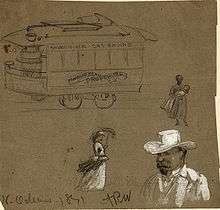
The raw energy density of liquid ammonia is 11.5 MJ/L,[71] which is about a third that of diesel. There is the opportunity to convert ammonia back to hydrogen, where it can be used to power hydrogen fuel cells or directly within high-temperature fuel cells.[72] The conversion of ammonia to hydrogen via the sodium amide process,[73] either for combustion or as fuel for a proton exchange membrane fuel cell,[71] is possible. Conversion to hydrogen would allow the storage of hydrogen at nearly 18 wt% compared to ≈5% for gaseous hydrogen under pressure.
Ammonia engines or ammonia motors, using ammonia as a working fluid, have been proposed and occasionally used.[74] The principle is similar to that used in a fireless locomotive, but with ammonia as the working fluid, instead of steam or compressed air. Ammonia engines were used experimentally in the 19th century by Goldsworthy Gurney in the UK and the St. Charles Avenue Streetcar line in New Orleans in the 1870s and 1880s,[75] and during World War II ammonia was used to power buses in Belgium.[76]
Ammonia is sometimes proposed as a practical alternative to fossil fuel for internal combustion engines.[76][77][78] Its high octane rating of 120[79] and low flame temperature[80] allows the use of high compression ratios without a penalty of high NOx production. Since ammonia contains no carbon, its combustion cannot produce carbon dioxide, carbon monoxide, hydrocarbons, or soot.
Even though ammonia production currently creates 1.8% of global CO2 emissions, the Royal Society report[81] claims that "green" ammonia can be produced by using low-carbon hydrogen (blue hydrogen and green hydrogen). Total decarbonization of ammonia production and the accomplishment of net-zero targets are possible by 2050.
However ammonia cannot be easily used in existing Otto cycle engines because of its very narrow flammability range, and there are also other barriers to widespread automobile usage. In terms of raw ammonia supplies, plants would have to be built to increase production levels, requiring significant capital and energy sources. Although it is the second most produced chemical (after sulfuric acid), the scale of ammonia production is a small fraction of world petroleum usage. It could be manufactured from renewable energy sources, as well as coal or nuclear power. The 60 MW Rjukan dam in Telemark, Norway produced ammonia for many years from 1913, providing fertilizer for much of Europe.
Despite this, several tests have been done. In 1981, a Canadian company converted a 1981 Chevrolet Impala to operate using ammonia as fuel.[82][83] In 2007, a University of Michigan pickup powered by ammonia drove from Detroit to San Francisco as part of a demonstration, requiring only one fill-up in Wyoming.[84]
Compared to hydrogen as a fuel, ammonia is much more energy efficient, and could be produced, stored, and delivered at a much lower cost than hydrogen which must be kept compressed as a cryogenic liquid.[71][85]
Rocket engines have also been fueled by ammonia. The Reaction Motors XLR99 rocket engine that powered the X-15 hypersonic research aircraft used liquid ammonia. Although not as powerful as other fuels, it left no soot in the reusable rocket engine, and its density approximately matches the density of the oxidizer, liquid oxygen, which simplified the aircraft's design.
As a stimulant
Ammonia, as the vapor released by smelling salts, has found significant use as a respiratory stimulant. Ammonia is commonly used in the illegal manufacture of methamphetamine through a Birch reduction.[87] The Birch method of making methamphetamine is dangerous because the alkali metal and liquid ammonia are both extremely reactive, and the temperature of liquid ammonia makes it susceptible to explosive boiling when reactants are added.[88]
Textile
Liquid ammonia is used for treatment of cotton materials, giving properties like mercerisation, using alkalis. In particular, it is used for prewashing of wool.[89]
Lifting gas
At standard temperature and pressure, ammonia is less dense than atmosphere and has approximately 45-48% of the lifting power of hydrogen or helium. Ammonia has sometimes been used to fill weather balloons as a lifting gas. Because of its relatively high boiling point (compared to helium and hydrogen), ammonia could potentially be refrigerated and liquefied aboard an airship to reduce lift and add ballast (and returned to a gas to add lift and reduce ballast).
Woodworking
Ammonia has been used to darken quartersawn white oak in Arts & Crafts and Mission-style furniture. Ammonia fumes react with the natural tannins in the wood and cause it to change colours.[90]
Energy carrier
In early August 2018, scientists from Australia's Commonwealth Scientific and Industrial Research Organisation (CSIRO) announced the success of developing a process to release hydrogen from ammonia and harvest that at ultra-high purity as a fuel for cars. This uses a special membrane. Two demonstration fuel cell vehicles have the technology, a Hyundai Nexo and Toyota Mirai.[91]
Safety precautions
The U.S. Occupational Safety and Health Administration (OSHA) has set a 15-minute exposure limit for gaseous ammonia of 35 ppm by volume in the environmental air and an 8-hour exposure limit of 25 ppm by volume.[93] The National Institute for Occupational Safety and Health (NIOSH) recently reduced the IDLH (Immediately Dangerous to Life and Health, the level to which a healthy worker can be exposed for 30 minutes without suffering irreversible health effects) from 500 to 300 based on recent more conservative interpretations of original research in 1943. Other organizations have varying exposure levels. U.S. Navy Standards [U.S. Bureau of Ships 1962] maximum allowable concentrations (MACs): continuous exposure (60 days): 25 ppm / 1 hour: 400 ppm.[94] Ammonia vapour has a sharp, irritating, pungent odour that acts as a warning of potentially dangerous exposure. The average odour threshold is 5 ppm, well below any danger or damage. Exposure to very high concentrations of gaseous ammonia can result in lung damage and death.[93] Ammonia is regulated in the United States as a non-flammable gas, but it meets the definition of a material that is toxic by inhalation and requires a hazardous safety permit when transported in quantities greater than 13,248 L (3,500 gallons).[95]
Liquid ammonia is dangerous because it is hygroscopic and because it can cause caustic burns. See Gas carrier § Health effects of specific cargoes carried on gas carriers for more information.
Toxicity
The toxicity of ammonia solutions does not usually cause problems for humans and other mammals, as a specific mechanism exists to prevent its build-up in the bloodstream. Ammonia is converted to carbamoyl phosphate by the enzyme carbamoyl phosphate synthetase, and then enters the urea cycle to be either incorporated into amino acids or excreted in the urine.[96] Fish and amphibians lack this mechanism, as they can usually eliminate ammonia from their bodies by direct excretion. Ammonia even at dilute concentrations is highly toxic to aquatic animals, and for this reason it is classified as dangerous for the environment.
Ammonia is a constituent of tobacco smoke.[97]
Coking wastewater
Ammonia is present in coking wastewater streams, as a liquid by-product of the production of coke from coal.[98] In some cases, the ammonia is discharged to the marine environment where it acts as a pollutant. The Whyalla steelworks in South Australia is one example of a coke-producing facility which discharges ammonia into marine waters.[99]
Aquaculture
Ammonia toxicity is believed to be a cause of otherwise unexplained losses in fish hatcheries. Excess ammonia may accumulate and cause alteration of metabolism or increases in the body pH of the exposed organism. Tolerance varies among fish species.[100] At lower concentrations, around 0.05 mg/L, un-ionised ammonia is harmful to fish species and can result in poor growth and feed conversion rates, reduced fecundity and fertility and increase stress and susceptibility to bacterial infections and diseases.[101] Exposed to excess ammonia, fish may suffer loss of equilibrium, hyper-excitability, increased respiratory activity and oxygen uptake and increased heart rate.[100] At concentrations exceeding 2.0 mg/L, ammonia causes gill and tissue damage, extreme lethargy, convulsions, coma, and death.[100][102] Experiments have shown that the lethal concentration for a variety of fish species ranges from 0.2 to 2.0 mg/l.[102]
During winter, when reduced feeds are administered to aquaculture stock, ammonia levels can be higher. Lower ambient temperatures reduce the rate of algal photosynthesis so less ammonia is removed by any algae present. Within an aquaculture environment, especially at large scale, there is no fast-acting remedy to elevated ammonia levels. Prevention rather than correction is recommended to reduce harm to farmed fish[102] and in open water systems, the surrounding environment.
Storage information
Similar to propane, anhydrous ammonia boils below room temperature when at atmospheric pressure. A storage vessel capable of 250 psi (1.7 MPa) is suitable to contain the liquid.[103] Ammonia is used in numerous different industrial application requiring carbon or stainless steel storage vessels. Ammonia with at least 0.2 percent by weight water content is not corrosive to carbon steel. NH3 carbon steel construction storage tanks with 0.2 percent by weight or more of water could last more than 50 years in service.[104] Ammonium compounds should never be allowed to come in contact with bases (unless in an intended and contained reaction), as dangerous quantities of ammonia gas could be released.
Household use
Solutions of ammonia (5–10% by weight) are used as household cleaners, particularly for glass. These solutions are irritating to the eyes and mucous membranes (respiratory and digestive tracts), and to a lesser extent the skin. Caution should be used that the chemical is never mixed into any liquid containing bleach, as a toxic gas may result. Mixing with chlorine-containing products or strong oxidants, such as household bleach, can generate chloramines.[105]
Laboratory use of ammonia solutions
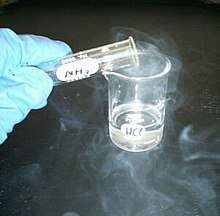
The hazards of ammonia solutions depend on the concentration: "dilute" ammonia solutions are usually 5–10% by weight (<5.62 mol/L); "concentrated" solutions are usually prepared at >25% by weight. A 25% (by weight) solution has a density of 0.907 g/cm3, and a solution that has a lower density will be more concentrated. The European Union classification of ammonia solutions is given in the table.
| Concentration by weight (w/w) |
Molarity | Concentration mass/volume (w/v) |
Classification | R-phrases |
|---|---|---|---|---|
| 5–10% | 2.87–5.62 mol/L | 48.9–95.7 g/L | Irritant (Xi) | R36/37/38 |
| 10–25% | 5.62–13.29 mol/L | 95.7–226.3 g/L | Corrosive (C) | R34 |
| >25% | >13.29 mol/L | >226.3 g/L |
|
R34, R50 |
The ammonia vapour from concentrated ammonia solutions is severely irritating to the eyes and the respiratory tract, and these solutions should only be handled in a fume hood. Saturated ("0.880" – see #Properties) solutions can develop a significant pressure inside a closed bottle in warm weather, and the bottle should be opened with care; this is not usually a problem for 25% ("0.900") solutions.
Ammonia solutions should not be mixed with halogens, as toxic and/or explosive products are formed. Prolonged contact of ammonia solutions with silver, mercury or iodide salts can also lead to explosive products: such mixtures are often formed in qualitative inorganic analysis, and should be lightly acidified but not concentrated (<6% w/v) before disposal once the test is completed.
Laboratory use of anhydrous ammonia (gas or liquid)
Anhydrous ammonia is classified as toxic (T) and dangerous for the environment (N). The gas is flammable (autoignition temperature: 651 °C) and can form explosive mixtures with air (16–25%). The permissible exposure limit (PEL) in the United States is 50 ppm (35 mg/m3), while the IDLH concentration is estimated at 300 ppm. Repeated exposure to ammonia lowers the sensitivity to the smell of the gas: normally the odour is detectable at concentrations of less than 50 ppm, but desensitised individuals may not detect it even at concentrations of 100 ppm. Anhydrous ammonia corrodes copper- and zinc-containing alloys, and so brass fittings should not be used for handling the gas. Liquid ammonia can also attack rubber and certain plastics.
Ammonia reacts violently with the halogens. Nitrogen triiodide, a primary high explosive, is formed when ammonia comes in contact with iodine. Ammonia causes the explosive polymerisation of ethylene oxide. It also forms explosive fulminating compounds with compounds of gold, silver, mercury, germanium or tellurium, and with stibine. Violent reactions have also been reported with acetaldehyde, hypochlorite solutions, potassium ferricyanide and peroxides.
Synthesis and production

Ammonia is one of the most produced inorganic chemicals, with global production reported at 175 million tonnes in 2018.[13] China accounted for 28.5% of that, followed by Russia at 10.3%, the United States at 9.1%, and India at 6.7%.[13]
Before the start of World War I, most ammonia was obtained by the dry distillation[106] of nitrogenous vegetable and animal waste products, including camel dung, where it was distilled by the reduction of nitrous acid and nitrites with hydrogen; in addition, it was produced by the distillation of coal, and also by the decomposition of ammonium salts by alkaline hydroxides[107] such as quicklime:[108]
For small scale laboratory synthesis, one can heat urea and calcium hydroxide:
Haber-Bosch process
Mass production of ammonia mostly uses the Haber–Bosch process, a gas phase reaction between hydrogen (H2) and nitrogen (N2) at a moderately-elevated temperature (450 °C) and high pressure (100 standard atmospheres (10 MPa)):[109]
This reaction is both exothermic and results in decreased entropy, meaning that the reaction is favoured at lower temperatures[110] and higher pressures.[111] This makes it difficult and expensive to achieve, as lower temperatures result in slower reaction kinetics (hence a slower reaction rate)[112] and high pressure requires high-strength pressure vessels[113] that aren't weakened by hydrogen embrittlement. In addition, diatomic nitrogen is bound together by an exceptionally strong triple bond, which makes it rather inert.[114] Both the yield and efficiency of the Haber-Bosch Process are low, meaning that ammonia produced must be continuously separated and extracted for the reaction to proceed at an appreciable pace.[115] Combined with the energy needed to produce hydrogen[note 1] and purified atmospheric nitrogen, ammonia production is a very energy-intensive process, consuming 1 to 2% of global energy, 3% of global carbon emissions,[117] and 3 to 5% of natural gas consumption.[118]
Liquid ammonia as a solvent
Liquid ammonia is the best-known and most widely studied nonaqueous ionising solvent. Its most conspicuous property is its ability to dissolve alkali metals to form highly coloured, electrically conductive solutions containing solvated electrons. Apart from these remarkable solutions, much of the chemistry in liquid ammonia can be classified by analogy with related reactions in aqueous solutions. Comparison of the physical properties of NH3 with those of water shows NH3 has the lower melting point, boiling point, density, viscosity, dielectric constant and electrical conductivity; this is due at least in part to the weaker hydrogen bonding in NH3 and because such bonding cannot form cross-linked networks, since each NH3 molecule has only one lone pair of electrons compared with two for each H2O molecule. The ionic self-dissociation constant of liquid NH3 at −50 °C is about 10−33.
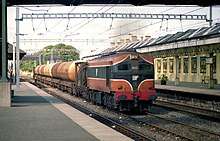
Solubility of salts
| Solubility (g of salt per 100 g liquid NH3) | |
|---|---|
| Ammonium acetate | 253.2 |
| Ammonium nitrate | 389.6 |
| Lithium nitrate | 243.7 |
| Sodium nitrate | 97.6 |
| Potassium nitrate | 10.4 |
| Sodium fluoride | 0.35 |
| Sodium chloride | 157.0 |
| Sodium bromide | 138.0 |
| Sodium iodide | 161.9 |
| Sodium thiocyanate | 205.5 |
Liquid ammonia is an ionising solvent, although less so than water, and dissolves a range of ionic compounds, including many nitrates, nitrites, cyanides, thiocyanates, metal cyclopentadienyl complexes and metal bis(trimethylsilyl)amides.[119] Most ammonium salts are soluble and act as acids in liquid ammonia solutions. The solubility of halide salts increases from fluoride to iodide. A saturated solution of ammonium nitrate (Divers' solution, named after Edward Divers) contains 0.83 mol solute per mole of ammonia and has a vapour pressure of less than 1 bar even at 25 °C (77 °F).
Solutions of metals
Liquid ammonia will dissolve all of the alkali metals and other electropositive metals such as Ca,[120] Sr, Ba, Eu, and Yb (also Mg using an electrolytic process[121]). At low concentrations (<0.06 mol/L), deep blue solutions are formed: these contain metal cations and solvated electrons, free electrons that are surrounded by a cage of ammonia molecules.
These solutions are very useful as strong reducing agents. At higher concentrations, the solutions are metallic in appearance and in electrical conductivity. At low temperatures, the two types of solution can coexist as immiscible phases.
Redox properties of liquid ammonia
| E° (V, ammonia) | E° (V, water) | |
|---|---|---|
| Li+ + e− ⇌ Li | −2.24 | −3.04 |
| K+ + e− ⇌ K | −1.98 | −2.93 |
| Na+ + e− ⇌ Na | −1.85 | −2.71 |
| Zn2+ + 2e− ⇌ Zn | −0.53 | −0.76 |
| NH4+ + e− ⇌ ½ H2 + NH3 | 0.00 | — |
| Cu2+ + 2e− ⇌ Cu | +0.43 | +0.34 |
| Ag+ + e− ⇌ Ag | +0.83 | +0.80 |
The range of thermodynamic stability of liquid ammonia solutions is very narrow, as the potential for oxidation to dinitrogen, E° (N2 + 6NH4+ + 6e− ⇌ 8NH3), is only +0.04 V. In practice, both oxidation to dinitrogen and reduction to dihydrogen are slow. This is particularly true of reducing solutions: the solutions of the alkali metals mentioned above are stable for several days, slowly decomposing to the metal amide and dihydrogen. Most studies involving liquid ammonia solutions are done in reducing conditions; although oxidation of liquid ammonia is usually slow, there is still a risk of explosion, particularly if transition metal ions are present as possible catalysts.
Ammonia's role in biological systems and human disease
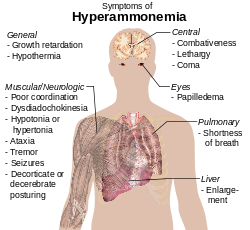
Ammonia is both a metabolic waste and a metabolic input throughout the biosphere. It is an important source of nitrogen for living systems. Although atmospheric nitrogen abounds (more than 75%), few living creatures are capable of using this atmospheric nitrogen in its diatomic form, N2 gas. Therefore, nitrogen fixation is required for the synthesis of amino acids, which are the building blocks of protein. Some plants rely on ammonia and other nitrogenous wastes incorporated into the soil by decaying matter. Others, such as nitrogen-fixing legumes, benefit from symbiotic relationships with rhizobia that create ammonia from atmospheric nitrogen.[123]
Biosynthesis
In certain organisms, ammonia is produced from atmospheric nitrogen by enzymes called nitrogenases. The overall process is called nitrogen fixation. Intense effort has been directed toward understanding the mechanism of biological nitrogen fixation; the scientific interest in this problem is motivated by the unusual structure of the active site of the enzyme, which consists of an Fe7MoS9 ensemble.[124]
Ammonia is also a metabolic product of amino acid deamination catalyzed by enzymes such as glutamate dehydrogenase 1. Ammonia excretion is common in aquatic animals. In humans, it is quickly converted to urea, which is much less toxic, particularly less basic. This urea is a major component of the dry weight of urine. Most reptiles, birds, insects, and snails excrete uric acid solely as nitrogenous waste.
In physiology
Ammonia also plays a role in both normal and abnormal animal physiology. It is biosynthesised through normal amino acid metabolism and is toxic in high concentrations. The liver converts ammonia to urea through a series of reactions known as the urea cycle. Liver dysfunction, such as that seen in cirrhosis, may lead to elevated amounts of ammonia in the blood (hyperammonemia). Likewise, defects in the enzymes responsible for the urea cycle, such as ornithine transcarbamylase, lead to hyperammonemia. Hyperammonemia contributes to the confusion and coma of hepatic encephalopathy, as well as the neurologic disease common in people with urea cycle defects and organic acidurias.[125]
Ammonia is important for normal animal acid/base balance. After formation of ammonium from glutamine, α-ketoglutarate may be degraded to produce two molecules of bicarbonate, which are then available as buffers for dietary acids. Ammonium is excreted in the urine, resulting in net acid loss. Ammonia may itself diffuse across the renal tubules, combine with a hydrogen ion, and thus allow for further acid excretion.[126]
Excretion
Ammonium ions are a toxic waste product of metabolism in animals. In fish and aquatic invertebrates, it is excreted directly into the water. In mammals, sharks, and amphibians, it is converted in the urea cycle to urea, because it is less toxic and can be stored more efficiently. In birds, reptiles, and terrestrial snails, metabolic ammonium is converted into uric acid, which is solid, and can therefore be excreted with minimal water loss.[127]
In astronomy
Ammonia has been detected in the atmospheres of the giant planets, including Jupiter, along with other gases like methane, hydrogen, and helium. The interior of Saturn may include frozen crystals of ammonia.[128] It is naturally found on Deimos and Phobos – the two moons of Mars.
Interstellar space
Ammonia was first detected in interstellar space in 1968, based on microwave emissions from the direction of the galactic core.[129] This was the first polyatomic molecule to be so detected. The sensitivity of the molecule to a broad range of excitations and the ease with which it can be observed in a number of regions has made ammonia one of the most important molecules for studies of molecular clouds.[130] The relative intensity of the ammonia lines can be used to measure the temperature of the emitting medium.
The following isotopic species of ammonia have been detected:
The detection of triply deuterated ammonia was considered a surprise as deuterium is relatively scarce. It is thought that the low-temperature conditions allow this molecule to survive and accumulate.[131]
Since its interstellar discovery, NH3 has proved to be an invaluable spectroscopic tool in the study of the interstellar medium. With a large number of transitions sensitive to a wide range of excitation conditions, NH3 has been widely astronomically detected – its detection has been reported in hundreds of journal articles. Listed below is a sample of journal articles that highlights the range of detectors that have been used to identify ammonia.
The study of interstellar ammonia has been important to a number of areas of research in the last few decades. Some of these are delineated below and primarily involve using ammonia as an interstellar thermometer.
Interstellar formation mechanisms
-3D-balls.png)
The interstellar abundance for ammonia has been measured for a variety of environments. The [NH3]/[H2] ratio has been estimated to range from 10−7 in small dark clouds[132] up to 10−5 in the dense core of the Orion Molecular Cloud Complex.[133] Although a total of 18 total production routes have been proposed,[134] the principal formation mechanism for interstellar NH3 is the reaction:
The rate constant, k, of this reaction depends on the temperature of the environment, with a value of 5.2×10−6 at 10 K.[135] The rate constant was calculated from the formula . For the primary formation reaction, a = 1.05×10−6 and B = −0.47. Assuming an NH4+ abundance of 3×10−7 and an electron abundance of 10−7 typical of molecular clouds, the formation will proceed at a rate of 1.6×10−9 cm−3s−1 in a molecular cloud of total density 105 cm−3.[136]
All other proposed formation reactions have rate constants of between 2 and 13 orders of magnitude smaller, making their contribution to the abundance of ammonia relatively insignificant.[137] As an example of the minor contribution other formation reactions play, the reaction:
has a rate constant of 2.2×10−15. Assuming H2 densities of 105 and [NH2]/[H2] ratio of 10−7, this reaction proceeds at a rate of 2.2×10−12, more than 3 orders of magnitude slower than the primary reaction above.
Some of the other possible formation reactions are:
Interstellar destruction mechanisms
There are 113 total proposed reactions leading to the destruction of NH3. Of these, 39 were tabulated in extensive tables of the chemistry among C, N, and O compounds.[138] A review of interstellar ammonia cites the following reactions as the principal dissociation mechanisms:[130]
with rate constants of 4.39×10−9[139] and 2.2×10−9,[140] respectively. The above equations (1, 2) run at a rate of 8.8×10−9 and 4.4×10−13, respectively. These calculations assumed the given rate constants and abundances of [NH3]/[H2] = 10−5, [H3+]/[H2] = 2×10−5, [HCO+]/[H2] = 2×10−9, and total densities of n = 105, typical of cold, dense, molecular clouds.[141] Clearly, between these two primary reactions, equation (1) is the dominant destruction reaction, with a rate ≈10,000 times faster than equation (2). This is due to the relatively high abundance of H3+.
Single antenna detections
Radio observations of NH3 from the Effelsberg 100-m Radio Telescope reveal that the ammonia line is separated into two components – a background ridge and an unresolved core. The background corresponds well with the locations previously detected CO.[142] The 25 m Chilbolton telescope in England detected radio signatures of ammonia in H II regions, HNH2O masers, H-H objects, and other objects associated with star formation. A comparison of emission line widths indicates that turbulent or systematic velocities do not increase in the central cores of molecular clouds.[143]
Microwave radiation from ammonia was observed in several galactic objects including W3(OH), Orion A, W43, W51, and five sources in the galactic centre. The high detection rate indicates that this is a common molecule in the interstellar medium and that high-density regions are common in the galaxy.[144]
Interferometric studies
VLA observations of NH3 in seven regions with high-velocity gaseous outflows revealed condensations of less than 0.1 pc in L1551, S140, and Cepheus A. Three individual condensations were detected in Cepheus A, one of them with a highly elongated shape. They may play an important role in creating the bipolar outflow in the region.[145]
Extragalactic ammonia was imaged using the VLA in IC 342. The hot gas has temperatures above 70 K, which was inferred from ammonia line ratios and appears to be closely associated with the innermost portions of the nuclear bar seen in CO.[146] NH3 was also monitored by VLA toward a sample of four galactic ultracompact HII regions: G9.62+0.19, G10.47+0.03, G29.96-0.02, and G31.41+0.31. Based upon temperature and density diagnostics, it is concluded that in general such clumps are probably the sites of massive star formation in an early evolutionary phase prior to the development of an ultracompact HII region.[147]
Infrared detections
Absorption at 2.97 micrometres due to solid ammonia was recorded from interstellar grains in the Becklin-Neugebauer Object and probably in NGC 2264-IR as well. This detection helped explain the physical shape of previously poorly understood and related ice absorption lines.[148]
A spectrum of the disk of Jupiter was obtained from the Kuiper Airborne Observatory, covering the 100 to 300 cm−1 spectral range. Analysis of the spectrum provides information on global mean properties of ammonia gas and an ammonia ice haze.[149]
A total of 149 dark cloud positions were surveyed for evidence of 'dense cores' by using the (J,K) = (1,1) rotating inversion line of NH3. In general, the cores are not spherically shaped, with aspect ratios ranging from 1.1 to 4.4. It is also found that cores with stars have broader lines than cores without stars.[150]
Ammonia has been detected in the Draco Nebula and in one or possibly two molecular clouds, which are associated with the high-latitude galactic infrared cirrus. The finding is significant because they may represent the birthplaces for the Population I metallicity B-type stars in the galactic halo that could have been borne in the galactic disk.[151]
Observations of nearby dark clouds
By balancing and stimulated emission with spontaneous emission, it is possible to construct a relation between excitation temperature and density. Moreover, since the transitional levels of ammonia can be approximated by a 2-level system at low temperatures, this calculation is fairly simple. This premise can be applied to dark clouds, regions suspected of having extremely low temperatures and possible sites for future star formation. Detections of ammonia in dark clouds show very narrow lines—indicative not only of low temperatures, but also of a low level of inner-cloud turbulence. Line ratio calculations provide a measurement of cloud temperature that is independent of previous CO observations. The ammonia observations were consistent with CO measurements of rotation temperatures of ≈10 K. With this, densities can be determined, and have been calculated to range between 104 and 105 cm−3 in dark clouds. Mapping of NH3 gives typical clouds sizes of 0.1 pc and masses near 1 solar mass. These cold, dense cores are the sites of future star formation.
UC HII regions
Ultra-compact HII regions are among the best tracers of high-mass star formation. The dense material surrounding UCHII regions is likely primarily molecular. Since a complete study of massive star formation necessarily involves the cloud from which the star formed, ammonia is an invaluable tool in understanding this surrounding molecular material. Since this molecular material can be spatially resolved, it is possible to constrain the heating/ionising sources, temperatures, masses, and sizes of the regions. Doppler-shifted velocity components allow for the separation of distinct regions of molecular gas that can trace outflows and hot cores originating from forming stars.
Extragalactic detection
Ammonia has been detected in external galaxies,[152][153] and by simultaneously measuring several lines, it is possible to directly measure the gas temperature in these galaxies. Line ratios imply that gas temperatures are warm (≈50 K), originating from dense clouds with sizes of tens of pc. This picture is consistent with the picture within our Milky Way galaxy—hot dense molecular cores form around newly forming stars embedded in larger clouds of molecular material on the scale of several hundred pc (giant molecular clouds; GMCs).
See also
- Ammonia (data page)
- Ammonia fountain – A type of chemical demonstration
- Ammonia production
- Ammonia solution – Chemical compound
- Cost of electricity by source – Comparison of costs of different electricity generation sources
- Forming gas
- Haber process – Main process of ammonia production
- Hydrazine – A colorless flammable liquid with an ammonia-like odor
- Water purification – process of removing undesirable chemicals, biological contaminants, suspended solids from water
Notes
- Hydrogen required for ammonia synthesis is most often produced through gasification of carbon-containing material, mostly natural gas, but other potential carbon sources include coal, petroleum, peat, biomass, or waste. As of 2012, the global production of ammonia produced from natural gas using the steam reforming process was 72 percent.[116] Hydrogen can also be produced from water and electricity using electrolysis: at one time, most of Europe's ammonia was produced from the Hydro plant at Vemork. Other possibilities include biological hydrogen production or photolysis, but at present, steam reforming of natural gas is the most economical means of mass-producing hydrogen.
References
- "NOMENCLATURE OF INORGANIC CHEMISTRY IUPAC Recommendations 2005" (PDF).
- "Gases – Densities". Retrieved 3 March 2016.
- Yost, Don M. (2007). "Ammonia and Liquid Ammonia Solutions". Systematic Inorganic Chemistry. READ BOOKS. p. 132. ISBN 978-1-4067-7302-6.
- Blum, Alexander (1975). "On crystalline character of transparent solid ammonia". Radiation Effects and Defects in Solids. 24 (4): 277. doi:10.1080/00337577508240819.
- Budavari, Susan, ed. (1996). The Merck Index: An Encyclopedia of Chemicals, Drugs, and Biologicals (12th ed.). Merck. ISBN 978-0-911910-12-4.
- Perrin, D. D., Ionisation Constants of Inorganic Acids and Bases in Aqueous Solution; 2nd Ed., Pergamon Press: Oxford, 1982.
- Iwasaki, Hiroji; Takahashi, Mitsuo (1968). "Studies on the transport properties of fluids at high pressure". The Review of Physical Chemistry of Japan. 38 (1).
- Zumdahl, Steven S. (2009). Chemical Principles 6th Ed. Houghton Mifflin Company. p. A22. ISBN 978-0-618-94690-7.
- Sigma-Aldrich Co., Ammonia. Retrieved on 20 July 2013.
- "Ammonia". Immediately Dangerous to Life and Health Concentrations (IDLH). National Institute for Occupational Safety and Health (NIOSH).
- NIOSH Pocket Guide to Chemical Hazards. "#0028". National Institute for Occupational Safety and Health (NIOSH).
- "40 C.F.R.: Appendix A to Part 355—The List of Extremely Hazardous Substances and Their Threshold Planning Quantities" (PDF) (1 July 2008 ed.). Government Printing Office. Archived from the original (PDF) on 25 February 2012. Retrieved 29 October 2011. Cite journal requires
|journal=(help) - "Mineral Commodity Summaries 2020, p. 117 – Nitrogen" (PDF). USGS. 2020. Retrieved 12 February 2020.
- "Nitrogen (fixed) - ammonia statistics". USGS. 2017. Retrieved 12 February 2020.
- R. Norris Shreve; Joseph Brink (1977). Chemical Process Industries (4th ed.). p. 276. ISBN 978-0-07-057145-7. See also Gas carrier and Bottled gas.
- "Ammonium hydroxide physical properties" (PDF). Archived from the original (PDF) on 27 November 2007.
- "Pliny the Elder, The Natural History, Book XXXI, Chapter 39. (7.) - The various kinds of salt; the methods of preparing it, and the remedies derived from it".
- Hoover, Herbert (1950). Georgius Agricola De Re Metallica - Translated from the first Latin edition of 1556. New York: Dover Publications. p. 560. ISBN 978-0486600062.
- Chisholm 1911, p. 861.
- Kirschbaum, B; Sica, D; Anderson, F. P. (1999). "Urine electrolytes and the urine anion and osmolar gaps". The Journal of Laboratory and Clinical Medicine. 133 (6): 597–604. doi:10.1016/S0022-2143(99)90190-7. ISSN 0022-2143. PMID 10360635.
- Shannon, Francis Patrick (1938) Tables of the properties of aqua-ammonia solutions. Part 1 of The Thermodynamics of Absorption Refrigeration. Lehigh University studies. Science and technology series
- An ammonia-water slurry may swirl below Pluto's icy surface. Purdue University (9 November 2015)
- Hewat, A. W.; Riekel, C. (1979). "The crystal structure of deuteroammonia between 2 and 180 K by neutron powder profile refinement". Acta Crystallographica Section A. 35 (4): 569. Bibcode:1979AcCrA..35..569H. doi:10.1107/S0567739479001340.
- Haynes, William M., ed. (2013). CRC Handbook of Chemistry and Physics (94th ed.). CRC Press. pp. 9–26. ISBN 9781466571143.
- Cleeton, C. E.; Williams, N. H. (1934). "Electromagnetic Waves of 1.1 cm (0 in). Wave-Length and the Absorption Spectrum of Ammonia". Physical Review. 45 (4): 234. Bibcode:1934PhRv...45..234C. doi:10.1103/PhysRev.45.234.
- Chisholm 1911, p. 862.
- Baker, H. B. (1894). "Influence of moisture on chemical change". J. Chem. Soc. 65: 611–624. doi:10.1039/CT8946500611.
- Kobayashi, Hideaki; Hayakawa, Akihiro; Somarathne, K.D. Kunkuma A.; Okafor, Ekenechukwu C. (2019). "Science and technology of ammonia combustion". Proceedings of the Combustion Institute. 37: 109–133. doi:10.1016/j.proci.2018.09.029.
- Khan, A.S.; Kelley, R.D.; Chapman, K.S.; Fenton, D.L. (1995). Flammability limits of ammonia-air mixtures. U.S.: U.S. DOE Office of Scientific and Technical Information. OSTI 215703.
- Shrestha, Krishna P.; Seidel, Lars; Zeuch, Thomas; Mauss, Fabian (7 July 2018). "Detailed Kinetic Mechanism for the Oxidation of Ammonia Including the Formation and Reduction of Nitrogen Oxides". Energy & Fuels. 32 (10): 10202–10217. doi:10.1021/acs.energyfuels.8b01056. ISSN 0887-0624.
- Sterrett, K. F.; Caron, A. P. (1966). "High pressure chemistry of hydrogenous fuels". Northrop Space Labs. Archived from the original on 23 August 2011. Retrieved 24 December 2009.
- Chisholm 1911, p. 863.
- (OSHA) Source: Sax, N. Irving (1984) Dangerous Properties of Industrial Materials. 6th Ed. Van Nostrand Reinhold. ISBN 0-442-28304-0.
- Hurtado, J. L. Martinez; Lowe, C. R. (2014). "Ammonia-Sensitive Photonic Structures Fabricated in Nafion Membranes by Laser Ablation". ACS Applied Materials & Interfaces. 6 (11): 8903–8908. doi:10.1021/am5016588. ISSN 1944-8244. PMID 24803236.
- Herodotus with George Rawlinson, trans., The History of Herodotus (New York, New York: Tandy-Thomas Co., 1909), vol.2, Book 4, § 181, pp. 304–305.
- The land of the Ammonians is mentioned elsewhere in Herodotus' History and in Pausanias' Description of Greece:
- Herodotus with George Rawlinson, trans., The History of Herodotus (New York, New York: Tandy-Thomas Co., 1909), vol. 1, Book 2, § 42, p. 245, vol. 2, Book 3, § 25, p. 73, and vol. 2, Book 3, § 26, p. 74.
- Pausanias with W.H.S. Jones, trans., Description of Greece (London, England: William Heinemann Ltd., 1979), vol. 2, Book 3, Ch. 18, § 3, pp. 109 and 111 and vol. 4, Book 9, Ch. 16, § 1, p. 239.
- Kopp, Hermann, Geschichte der Chemie [History of Chemistry] (Braunschweig, (Germany): Friedrich Vieweg und Sohn, 1845), Part 3, p. 237. [in German]
- Chisholm 1911 cites Pliny Nat. Hist. xxxi. 39. See: Pliny the Elder with John Bostock and H. T. Riley, ed.s, The Natural History (London, England: H. G. Bohn, 1857), vol. 5, Book 31, § 39, p. 502.
- "Sal-ammoniac". Webmineral. Retrieved 7 July 2009.
- Pliny also mentioned that when some samples of what was purported to be natron (Latin: nitrum, impure sodium carbonate) were treated with lime (calcium carbonate) and water, the natron would emit a pungent smell, which some authors have interpreted as signifying that the natron either was ammonium chloride or was contaminated with it. See:
- Pliny with W.H.S. Jones, trans., Natural History (London, England: William Heinemann Ltd., 1963), vol. 8, Book 31, § 46, pp. 448–449. From pp. 448–449: "Adulteratur in Aegypto calce, deprehenditur gusto. Sincerum enim statim resolvitur, adulteratum calce pungit et asperum [or aspersum] reddit odorem vehementer." (In Egypt it [i.e., natron] is adulterated with lime, which is detected by taste; for pure natron melts at once, but adulterated natron stings because of the lime, and emits a strong, bitter odour [or: when sprinkled [(aspersum) with water] emits a vehement odour])
- Kidd, John, Outlines of Mineralogy (Oxford, England: N. Bliss, 1809), vol. 2, p. 6.
- Moore, Nathaniel Fish, Ancient Mineralogy: Or, An Inquiry Respecting Mineral Substances Mentioned by the Ancients: ... (New York, New York: G. & C. Carvill & Co., 1834), pp. 96–97.
- See:
- Forbes, R.J., Studies in Ancient Technology, vol. 5, 2nd ed. (Leiden, Netherlands: E.J. Brill, 1966), pp. 19, 48, and 65.
- Moeller, Walter O., The Wool Trade of Ancient Pompeii (Leiden, Netherlands: E.J. Brill, 1976), p. 20.
- Faber, G.A. (pseudonym of: Goldschmidt, Günther) (May 1938) "Dyeing and tanning in classical antiquity," Ciba Review, 9 : 277–312. Available at: Elizabethan Costume
- Smith, William, A Dictionary of Greek and Roman Antiquities (London, England: John Murray, 1875), article: "Fullo" (i.e., fullers or launderers), pp. 551–553.
- Rousset, Henri (31 March 1917) "The laundries of the Ancients," Scientific American Supplement, 83 (2152) : 197.
- Bond, Sarah E., Trade and Taboo: Disreputable Professions in the Roman Mediterranean (Ann Arbor, Michigan: University of Michigan Press, 2016), p. 112.
- Binz, Arthur (1936) "Altes und Neues über die technische Verwendung des Harnes" (Ancient and modern [information] about the technological use of urine), Zeitschrift für Angewandte Chemie, 49 (23) : 355–360. [in German]
- Witty, Michael (December 2016) "Ancient Roman urine chemistry," Acta Archaeologica, 87 (1) : 179–191. Witty speculates that the Romans obtained ammonia in concentrated form by adding wood ash (impure potassium carbonate) to urine that had been fermented for several hours. Struvite (magnesium ammonium phosphate) is thereby precipitated, and the yield of struvite can be increased by then treating the solution with bittern, a magnesium-rich solution that is a byproduct of making salt from sea water. Roasting struvite releases ammonia vapors.
- Haq, Syed Nomanul (1995). Names, Natures and Things: The Alchemist Jabir Ibn Hayyan and His Kitab Al-Ahjar (Book of Stones). Springer. ISBN 978-0-7923-3254-1.
- Spiritus salis urinæ (spirit of the salt of urine, i.e., ammonium carbonate) had apparently been produced before Valentinus, although he presented a new, simpler method for preparing it in his book: Valentinus, Basilius, Vier Tractätlein Fr. Basilii Valentini ... [Four essays of Brother Basil Valentine ... ] (Frankfurt am Main, (Germany): Luca Jennis, 1625), "Supplementum oder Zugabe" (Supplement or appendix), pp. 80–81: "Der Weg zum Universal, damit die drei Stein zusammen kommen." (The path to the Universal, so that the three stones come together.). From p. 81: "Der Spiritus salis Urinæ nimbt langes wesen zubereiten / dieser proceß aber ist waß leichter unnd näher auß dem Salz von Armenia, ... Nun nimb sauberen schönen Armenischen Salz armoniac ohn alles sublimiren / thue ihn in ein Kolben / giesse ein Oleum Tartari drauff / daß es wie ein Muß oder Brey werde / vermachs baldt / dafür thu auch ein grosen vorlag / so lege sich als baldt der Spiritus Salis Urinæ im Helm an Crystallisch ... " (Spirit of the salt of urine [i.e., ammonium carbonate] requires a long method [i.e., procedure] to prepare; this [i.e., Valentine's] process [starting] from the salt from Armenia [i.e., ammonium chloride], however, is somewhat easier and shorter ... Now take clean nice Armenian salt, without sublimating all [of it]; put it in a [distillation] flask; pour oil of tartar [i.e., potassium carbonate that has dissolved only in the water that it has absorbed from the air] on it, [so] that it [i.e., the mixture] becomes like a mush or paste; assemble it [i.e., the distilling apparatus (alembic)] quickly; for that [purpose] connect a large receiving flask; then soon spirit of the salt of urine deposits as crystals in the "helmet" [i.e., the outlet for the vapors, which is atop the distillation flask] ...)
See also: Kopp, Hermann, Geschichte der Chemie [History of Chemistry] (Braunschweig, (Germany): Friedrich Vieweg und Sohn, 1845), Part 3, p. 243. [in German] - Maurice P. Crosland (2004). Historical Studies in the Language of Chemistry. Courier Dover Publications. p. 72. ISBN 978-0-486-43802-3.
- Black, Joseph (1893) [1755]. Experiments upon magnesia alba, quick-lime, and other alcaline substances. Edinburgh: W.F. Clay.
- Jacobson, Mark Z. (23 April 2012). Air Pollution and Global Warming: History, Science, and Solutions. Cambridge University Press. ISBN 9781107691155.
- "Woulfe's bottle". Chemistry World. Retrieved 1 July 2017.
- Woulfe, Peter (1 January 1767). "Experiments on the Distillation of Acids, Volatile Alkalies, &c. Shewing How They May be Condensed without Loss, and How Thereby We May Avoid Disagreeable and Noxious Fumes: In a Letter from Mr. Peter Woulfe, F. R. S. to John Ellis, Esq; F. R. S." Philosophical Transactions. 57: 517–536. Bibcode:1767RSPT...57..517W. doi:10.1098/rstl.1767.0052. ISSN 0261-0523.
- Pictorial life history of the apothecary chemist Carl Wilhelm Scheele. American Institute of the History of Pharmacy. 1942. hdl:1811/28946/Pictorial%20Life%20History_Scheele.pdf.
- See:
- Priestley, Joseph (1773) "Extrait d'une lettre de M. Priestley, en date du 14 Octobre 1773" (Extract of a letter from Mr. Priestley, dated 14 October 1773), Observations sur la Physique ..., 2 : 389.
- Priestley, Joseph, Experiments and Observations on Different Kinds of Air, vol. 1, 2nd ed. (London, England: 1775), Part 2, § 1: Observations on Alkaline Air, pp. 163–177.
- Schofield, Robert E., The Enlightened Joseph Priestley: A Study of His Life and Work from 1773 to 1804 (University Park, Pennsylvania: Pennsylvania State University Press, 2004), pp. 93–94.
- By 1775, Priestley had observed that electricity could decompose ammonia ("alkaline air"), yielding a flammable gas (hydrogen). See: Priestley, Joseph, Experiments and Observations on Different Kinds of Air, vol. 2 (London, England: J. Johnson, 1775), pp. 239–240.
- Berthollet (1785) "Analyse de l'alkali volatil" (Analysis of volatile alkali), Mémoires de l'Académie Royale des Sciences, 316–326.
- Max Appl (2006). "Ammonia". Ammonia, in Ullmann's Encyclopedia of Industrial Chemistry. Weinheim: Wiley-VCH. doi:10.1002/14356007.a02_143.pub2. ISBN 978-3527306732.
- Smith, Roland (2001). Conquering Chemistry. Sydney: McGraw-Hill. ISBN 978-0-07-470146-1.
- Lassaletta, Luis; Billen, Gilles; Grizzetti, Bruna; Anglade, Juliette; Garnier, Josette (2014). "50-year trends in nitrogen use efficiency of world cropping systems: the relationship between yield and nitrogen input to cropland". Environmental Research Letters. 9 (10): 105011. Bibcode:2014ERL.....9j5011L. doi:10.1088/1748-9326/9/10/105011. ISSN 1748-9326.
- David Brown (18 April 2013). "Anhydrous ammonia fertilizer: abundant, important, hazardous". Washington Post. Retrieved 23 April 2013.
- Holleman, A. F.; Wiberg, E. (2001). Inorganic Chemistry. San Diego: Academic Press. ISBN 978-0-12-352651-9.
- "The Facts About Ammonia". www.health.ny.gov. Retrieved 6 April 2018.
- "OSHA Hazard Communication Standard: Safety Data Sheets" (PDF). OSHA.
- Samuel Rideal (1895). Disinfection and Disinfectants: An Introduction to the Study of. London: Charles Griffin and Company. p. 109.
- Tajkarimi, Mehrdad; Riemann, H. P.; Hajmeer, M. N.; Gomez, E. L.; Razavilar, V.; Cliver, D. O.; et al. (2008). "Ammonia disinfection of animal feeds – Laboratory study". International Journal of Food Microbiology. 122 (1–2): 23–28. doi:10.1016/j.ijfoodmicro.2007.11.040. PMID 18155794.
- Kim, JS; Lee, YY; Kim, TH (January 2016). "A review on alkaline pretreatment technology for bioconversion of lignocellulosic biomass". Bioresource Technology. 199: 42–48. doi:10.1016/j.biortech.2015.08.085. PMID 26341010.
- "Evaluation of Treatment Methods for Reducing Bacteria in Textured Beef", Jensen, Jean L et al., American Society of Agricultural and Biological Engineers Annual Meeting 2009
- Reference Document: Antimicrobial Interventions for Beef, Dawna Winkler and Kerri B. Harris, Center for Food Safety, Department of Animal Science, Texas A&M University, May 2009, page 12
- Moss, Michael (3 October 2009). "The Burger That Shattered Her Life". The New York Times.
- Moss, Michael (31 December 2009). "Safety of Beef Processing Method Is Questioned". The New York Times.
- Wright, Jerry (13 April 2015). "Cooling System Keeps Space Station Safe, Productive". NASA. Retrieved 1 July 2017.
- "International Space Station's Cooling System: How It Works (Infographic)". Space.com. Retrieved 1 July 2017.
- "Reducing Hydrofluorocarbon (HFC) Use and Emissions in the Federal Sector through SNAP" (PDF). Retrieved 2 December 2018.
- "Diesel: Greener Than You Think". Retrieved 7 July 2009.
- "Phosgene: Health and Safety Guide". International Programme on Chemical Safety. 1998.
- Lan, Rong; Tao, Shanwen (28 August 2014). "Ammonia as a suitable fuel for fuel cells". Frontiers in Energy Research. 2: 35. doi:10.3389/fenrg.2014.00035.
- Giddey, S.; Badwal, S. P. S.; Munnings, C.; Dolan, M. (10 October 2017). "Ammonia as a Renewable Energy Transportation Media". ACS Sustainable Chemistry & Engineering. 5 (11): 10231–10239. doi:10.1021/acssuschemeng.7b02219.
- David, William I. F.; Makepeace, Joshua W.; Callear, Samantha K.; Hunter, Hazel M. A.; Taylor, James D.; Wood, Thomas J.; Jones, Martin O. (24 September 2014). "Hydrogen Production from Ammonia Using Sodium Amide". Journal of the American Chemical Society. 136 (38): 13082–13085. doi:10.1021/ja5042836. ISSN 0002-7863. PMID 24972299.
- Douglas Self (1 October 2007). "Ammonia Motors". Retrieved 28 November 2010.
- Louis C. Hennick; Elbridge Harper Charlton (1965). The Streetcars of New Orleans. Pelican Publishing. pp. 14–16. ISBN 9781455612598.
- "Ammonia as a Transportation Fuel IV" (PDF). Norm Olson – Iowa Energy Center. 15–16 October 2007. Archived from the original (PDF) on 7 February 2012.
- Lee, Dongeun; Min, Hyungeun; Park, Hyunho; Song, Han Ho (1 November 2017). "Development of new combustion strategy for internal combustion engine fueled by pure ammonia" (PDF). Seoul National University, Department of Mechanical Engineering. Retrieved 29 January 2019.
- Brohi, Emtiaz Ali (2014). "Ammonia as fuel for internal combustion engines?" (PDF). Chalmers University of Technology. Retrieved 29 January 2019.
- "Ammonia". chm.bris.ac.uk. Retrieved 3 March 2016.
- Zacharakis-Jutz, George; Kong, Song-Charng (2013). "Characteristics of an SI Engine Using Direct Ammonia Injection" (PDF). Department of Mechanical Engineering, Iowa State University. Retrieved 29 January 2019.
- "Ammonia: zero-carbon fertiliser, fuel and energy store".
- Ammonia Powered Car on YouTube
- "Watch 'Ammonia Fuel'". Greg Vezina. Retrieved 7 July 2009.
- "Welcome to NH3 Car". NH3Car.com.
- Lindzon, Jared (27 February 2019). "He's Creating a New Fuel Out of Thin Air – for 85 Cents per Gallon". OZY. Retrieved 26 April 2019.
- The Gazette Staff (6 October 2009). "Anhydrous ammonia tank locks have flaws". Cedar Rapids Gazette.
- "Illinois Attorney General | Basic Understanding of Meth". Illinoisattorneygeneral.gov. Archived from the original on 10 September 2010. Retrieved 21 May 2011.
- Greenberg, Michael I. (1 January 2003). Occupational, Industrial, and Environmental Toxicology. Elsevier Health Sciences. ISBN 978-0323013406.
- Włochowicz, A.; Stelmasiak, E. (1983). "Change in thermal properties of wool after treatment with liquid ammonia". Journal of Thermal Analysis and Calorimetry. 26 (1): 17. doi:10.1007/BF01914084. S2CID 96930751.
- Fuming white oak. woodweb.com
- 'Carbon-free fuel': Australian hydrogen car breakthrough could go global, Lexy Hamilton-Smith, ABC News Online, 2018-08-08
- minerals year book, vol. 3
- "Toxic FAQ Sheet for Ammonia" (PDF). Agency for Toxic Substances and Disease Registry (ATSDR). September 2004.
- Ammonia, IDLH Documentation
- Is Anhydrous Ammonia covered under the Hazardous Materials Safety Permit Program? from the website of the United States Department of Transportation (DOT)
- Berg, JM; Tymoczko, JL; Stryer, L (2002). "23.4: Ammonium Ion is Converted into Urea in Most Terrestrial Vertebrates". Biochemistry (5th ed.).
- Talhout, Reinskje; Schulz, Thomas; Florek, Ewa; Van Benthem, Jan; Wester, Piet; Opperhuizen, Antoon (2011). "Hazardous Compounds in Tobacco Smoke". International Journal of Environmental Research and Public Health. 8 (12): 613–628. doi:10.3390/ijerph8020613. ISSN 1660-4601. PMC 3084482. PMID 21556207.
- "Cutting-Edge Solutions For Coking Wastewater Reuse To Meet The Standard of Circulation Cooling Systems". www.wateronline.com. Retrieved 16 January 2016.
- Vasudevan Rajaram; Subijoy Dutta; Krishna Parameswaran (30 June 2005). Sustainable Mining Practices: A Global Perspective. CRC Press. p. 113. ISBN 978-1-4398-3423-7.
- Oram, Brian. "Ammonia in Groundwater, Runoff, and Streams". The Water Centre. Retrieved 3 December 2014.
- Hargreaves, J.A.; Tucker, C.S. (2004). Managing ammonia in fish ponds. Southern Regional Aquaculture Center.
- Sergeant, Chris (5 February 2014). "The Management of Ammonia Levels in an Aquaculture Environment". Water/Wastewater. Retrieved 3 December 2014.
- Electronic Code of Federal Regulations: Archived 4 November 2011 at the Wayback Machine. Ecfr.gpoaccess.gov. Retrieved on 22 December 2011.
- https://ammoniatanks.com/
- Rizk-Ouaini, Rosette; Ferriol, Michel; Gazet, Josette; Saugier-Cohen Adad; Marie Therese (2006). Oxidation reaction of ammonia with sodium hypochlorite. Production and degradation reactions of chloramines. Bulletin de la Société Chimique de France. 4. p. 512. doi:10.1002/14356007.a02_143.pub2. ISBN 978-3527306732.
- "Nobel Prize in Chemistry (1918) – Haber-Bosch process". Retrieved 7 July 2009.
- "Chemistry of the Group 2 Elements – Be, Mg, Ca, Sr, Ba, Ra". BBC.co.uk. Retrieved 7 July 2009.
- See (Chisholm 1911), page 861.
- Atkins, P.W.; Overton, T.L.; Rourke, J.P.; Weller, M.T. and Armstrong, F.A. (2010) Shriver and Atkins Inorganic Chemistry. 5th Edi. W. H. Freeman and Company, New York. p. 383. ISBN 978-1-42-921820-7
- See (Clark 2013): "The forward reaction (the production of ammonia) is exothermic. According to Le Chatelier's Principle, this will be favoured if you lower the temperature. The system will respond by moving the position of equilibrium to counteract this – in other words by producing more heat. In order to get as much ammonia as possible in the equilibrium mixture, you need as low a temperature as possible".
- See (Clark 2013): "Notice that there are 4 molecules on the left-hand side of the equation, but only 2 on the right. According to Le Chatelier's Principle, if you increase the pressure the system will respond by favouring the reaction which produces fewer molecules. That will cause the pressure to fall again. In order to get as much ammonia as possible in the equilibrium mixture, you need as high a pressure as possible. 200 atmospheres is a high pressure, but not amazingly high".
- See (Clark 2013): "However, 400–450 °C isn't a low temperature! Rate considerations: The lower the temperature you use, the slower the reaction becomes. A manufacturer is trying to produce as much ammonia as possible per day. It makes no sense to try to achieve an equilibrium mixture which contains a very high proportion of ammonia if it takes several years for the reaction to reach that equilibrium".
- See (Clark 2013): "Rate considerations: Increasing the pressure brings the molecules closer together. In this particular instance, it will increase their chances of hitting and sticking to the surface of the catalyst where they can react. The higher the pressure the better in terms of the rate of a gas reaction. Economic considerations: Very high pressures are very expensive to produce on two counts. You have to build extremely strong pipes and containment vessels to withstand the very high pressure. That increases your capital costs when the plant is built".
- "Chemistry of Nitrogen". Compounds. Chem.LibreTexts.org. 5 June 2019. Retrieved 7 July 2019.
- See (Clark 2013): "At each pass of the gases through the reactor, only about 15% of the nitrogen and hydrogen converts to ammonia. (This figure also varies from plant to plant.) By continual recycling of the unreacted nitrogen and hydrogen, the overall conversion is about 98%".
- "Ammonia". Industrial Efficiency Technology & Measures. 30 April 2013. Retrieved 6 April 2018.
- Lehigh University (9 July 2018). "Electrochemically-produced ammonia could revolutionize food production". Retrieved 15 December 2018.
Ammonia manufacturing consumes 1 to 2% of total global energy and is responsible for approximately 3% of global carbon dioxide emissions.
- Song, Yang; Hensley, Dale; Bonnesen, Peter; Liang, Liango; Huang, Jingsong; Baddorf, Arthur; Tschaplinski, Timothy; Engle, Nancy; Wu, Zili; Cullen, David; Meyer, Harry III; Sumpter, Bobby; Rondinone, Adam (2 May 2018). "A physical catalyst for the electrolysis of nitrogen to ammonia". Science Advances. Oak Ridge National Laboratory. 4 (4): e1700336. Bibcode:2018SciA....4E0336S. doi:10.1126/sciadv.1700336. PMC 5922794. PMID 29719860. Retrieved 15 December 2018.
Ammonia synthesis consumes 3 to 5% of the world's natural gas, making it a significant contributor to greenhouse gas emissions.
- Neufeld, R.; Michel, R.; Herbst-Irmer, R.; Schöne, R.; Stalke, D. (2016). "Introducing a Hydrogen-Bond Donor into a Weakly Nucleophilic Brønsted Base: Alkali Metal Hexamethyldisilazides (MHMDS, M = Li, Na, K, Rb and Cs) with Ammonia". Chem. Eur. J. 22 (35): 12340–12346. doi:10.1002/chem.201600833. PMID 27457218.
- Edwin M. Kaiser (2001). "Calcium-Ammonia". Calcium–Ammonia. Encyclopedia of Reagents for Organic Synthesis. doi:10.1002/047084289X.rc003. ISBN 978-0471936237.
- Combellas, C; Kanoufi, F; Thiébault, A (2001). "Solutions of solvated electrons in liquid ammonia". Journal of Electroanalytical Chemistry. 499: 144–151. doi:10.1016/S0022-0728(00)00504-0.
- Roth, Karl S. "eMedicine Specialties > Metabolic Diseases > Hyperammonemia". Retrieved 7 July 2009.
- Adjei, M. B.; Quesenberry, K. H.; Chamblis, C. G. (June 2002). "Nitrogen Fixation and Inoculation of Forage Legumes". University of Florida IFAS Extension. Archived from the original on 20 May 2007.
- Igarashi, Robert Y.; Laryukhin, Mikhail; Dos Santos, Patricia C.; Lee, Hong-In; Dean, Dennis R.; Seefeldt, Lance C.; Hoffman, Brian M. (May 2005). "Trapping H- Bound to the Nitrogenase FeMo-Cofactor Active Site during H2 Evolution: Characterization by ENDOR Spectroscopy". Journal of the American Chemical Society. 127 (17): 6231–6241. doi:10.1021/ja043596p. PMID 15853328.
- Zschocke, Johannes; Hoffman, Georg (2004). Vademecum Metabolism. Schattauer Verlag. ISBN 978-3794523856.
- Rose, Burton; Helmut Rennke (1994). Renal Pathophysiology. Baltimore: Williams & Wilkins. ISBN 978-0-683-07354-6.
- Campbell, Neil A.; Jane B. Reece (2002). "44". Biology (6th ed.). San Francisco: Pearson Education, Inc. pp. 937–938. ISBN 978-0-8053-6624-2.
- Edited by Kirk Munsell. Image page credit Lunar and Planetary Institute. NASA. "NASA's Solar Exploration: Multimedia: Gallery: Gas Giant Interiors Archived 20 February 2006 at the Wayback Machine". Retrieved 26 April 2006.
- Cheung, A. C.; Rank, D. M.; Townes, C. H.; Thornton, D. D.; Welch, W. J. (1968). "Detection of NH3 molecules in the interstellar medium by their microwave emission". Phys. Rev. Lett. 21 (25): 1701. Bibcode:1968PhRvL..21.1701C. doi:10.1103/PhysRevLett.21.1701.
- Ho, P. T. P.; Townes, C. H. (1983). "Interstellar ammonia". Annu. Rev. Astron. Astrophys. 21 (1): 239–70. Bibcode:1983ARA&A..21..239H. doi:10.1146/annurev.aa.21.090183.001323.
- Millar, T. J. (2003). "Deuterium Fractionation in Interstellar Clouds". Space Science Reviews. 106 (1): 73–86. Bibcode:2003SSRv..106...73M. doi:10.1023/A:1024677318645. S2CID 189793190.
- Ungerechts, H.; Walmsley, C. M.; Winnewisser, G. (1980). "Ammonia and cyanoacetylene observations of the high-density core of L-183 (L-134-N)". Astron. Astrophys. 88: 259. Bibcode:1980A&A....88..259U.
- Genzel, R.; Downes, D.; Ho, P. T. P. (1982). "NH3 in Orion-KL – A new interpretation". Astrophysical Journal. 259: L103. Bibcode:1982ApJ...259L.103G. doi:10.1086/183856.
- "The UMIST data for Astrochemistry". Retrieved 7 July 2009.
- Vikor, L.; Al-Khalili, A.; Danared, H.; Djuric, N.; Dunn, G. H.; Larsson, M.; Le Padellec, A.; Rosaen, S.; Af Ugglas, M. (1999). "Branching fractions of dissociative recombination of NH4+ and NH2+ molecular ions". Astronomy and Astrophysics. 344: 1027. Bibcode:1999A&A...344.1027V.
- van Dishoeck, E. F.; Black, J. H. (1986). "Comprehensive models of diffuse interstellar clouds – Physical conditions and molecular abundances" (PDF). Astrophys. J. Suppl. Ser. 62: 109–145. Bibcode:1986ApJS...62..109V. doi:10.1086/191135. hdl:1887/1980.
- "astrochemistry.net". astrochemistry.net. Retrieved 21 May 2011.
- Prasad, S. S.; Huntress, W. T. (1980). "A model for gas phase chemistry in interstellar clouds". The Astrophysical Journal Supplement Series. 43: 1. Bibcode:1980ApJS...43....1P. doi:10.1086/190665.
- Lininger, W.; Albritton, D. L.; Fehsenfeld, F. C.; Schmeltekopf, A. L.; Ferguson, E. E. (1975). "Flow–drift tube measurements of kinetic energy dependences of some exothermic proton transfer rate constants". J. Chem. Phys. 62 (9): 3549. Bibcode:1975JChPh..62.3549L. doi:10.1063/1.430946.
- Smith, D.; Adams, N. G. (1977). "Reactions of CH+n IONS with ammonia at 300 K". Chemical Physics Letters. 47 (1): 145. Bibcode:1977CPL....47..145S. doi:10.1016/0009-2614(77)85326-8.
- Wooten, A.; Bozyan, E. P.; Garrett, D. B. (1980). "Detection of C2H in cold dark clouds". Astrophysical Journal. 239: 844. Bibcode:1980ApJ...239..844W. doi:10.1086/158168.
- Wilson, T. L.; Downes, D.; Bieging, J. (1979). "Ammonia in Orion". Astronomy and Astrophysics. 71 (3): 275. Bibcode:1979A&A....71..275W.
- MacDonald, G. H.; Little, L. T.; Brown, A. T.; Riley, P. W.; Matheson, D. N.; Felli, M. (1981). "Detection of new ammonia sources". MNRAS. 195 (2): 387. Bibcode:1981MNRAS.195..387M. doi:10.1093/mnras/195.2.387.
- Morris, M., Zuckerman, B., Palmer, P., Turner, B. E. (1973). "Interstellar ammonia". Astrophysical Journal. 186: 501. Bibcode:1973ApJ...186..501M. doi:10.1086/152515.CS1 maint: uses authors parameter (link)
- Torrelles, J. M., Ho, P. T. P., Rodriguez, L. F., Canto, J. (1985). "VLA observations of ammonia and continuum in regions with high-velocity gaseous outflows". Astrophysical Journal. 288: 595. Bibcode:1985ApJ...288..595T. doi:10.1086/162825.CS1 maint: uses authors parameter (link)
- Ho, P. T. P., Martin, R. N., Turner, J. L., Jackson, J. M. (1990). "VLA imaging of extragalactic ammonia – Hot gas in the nucleus of IC 342". Astrophysical Journal Letters. 355: L19. Bibcode:1990ApJ...355L..19H. doi:10.1086/185728.CS1 maint: uses authors parameter (link)
- Cesaroni, R., Churchwell, E., Hofner, P., Walmsley, C. M., Kurtz, S. (1994). "Hot ammonia toward compact HII regions". Astronomy and Astrophysics. 288: 903. Bibcode:1994A&A...288..903C.CS1 maint: uses authors parameter (link)
- Knacke, R. F., McCorkle, S., Puetter, R. C., Erickson, E. F., Kraetschmer, W. (1982). "Observation of interstellar ammonia ice". Astrophysical Journal. 260: 141. Bibcode:1982ApJ...260..141K. doi:10.1086/160241.CS1 maint: uses authors parameter (link)
- Orton, G. S., Aumann, H. H., Martonchik, J. V., Appleby, J. F. (1982). "Airborne spectroscopy of Jupiter in the 100- to 300-cm−1 region: Global properties of ammonia gas and ice haze". Icarus. 52 (1): 81. Bibcode:1982Icar...52...81O. doi:10.1016/0019-1035(82)90170-1.CS1 maint: uses authors parameter (link)
- Benson, P. J.; Myers, P. (1989). "A survey for dense cores in dark clouds". Astrophysical Journal Supplement Series. 71: 89. Bibcode:1989ApJS...71...89B. doi:10.1086/191365.
- Mebold, U., Heithausen, A., Reif, K. (1987). "Ammonia in the galactic halo and the infrared cirrus". Astronomy and Astrophysics. 180: 213. Bibcode:1987A&A...180..213M.CS1 maint: uses authors parameter (link)
- Martin, R. N.; Ho, P. T. P. (1979). "Detection of extragalactic ammonia". Astronomy and Astrophysics. 74 (1): L7. Bibcode:1979A&A....74L...7M.
- Takano, S.; Nakai, N.; Kawaguchi, K. (1 April 2002). "Observations of Ammonia in External Galaxies I. NGC 253 and M 82". Publications of the Astronomical Society of Japan. 54 (2): 195–207. Bibcode:2002PASJ...54..195T. doi:10.1093/pasj/54.2.195.
Works Cited
- "Aqua Ammonia". airgasspecialtyproducts.com. Archived from the original on 19 November 2010. Retrieved 28 November 2010.

- Clark, Jim (April 2013) [2002]. "THE HABER PROCESS". Retrieved 15 December 2018.
Further reading
- Bretherick, L., ed. (1986). Hazards in the Chemical Laboratory (4th ed.). London: Royal Society of Chemistry. ISBN 978-0-85186-489-1. OCLC 16985764.
- Greenwood, Norman N.; Earnshaw, Alan (1997). Chemistry of the Elements (2nd ed.). Butterworth-Heinemann. ISBN 978-0-08-037941-8.
- Housecroft, C. E.; Sharpe, A. G. (2000). Inorganic Chemistry (1st ed.). New York: Prentice Hall. ISBN 978-0-582-31080-3.
- Weast, R. C., ed. (1972). Handbook of Chemistry and Physics (53rd ed.). Cleveland, OH: Chemical Rubber Co.
External links
| Wikimedia Commons has media related to Ammonia. |
- International Chemical Safety Card 0414 (anhydrous ammonia), ilo.org.
- International Chemical Safety Card 0215 (aqueous solutions), ilo.org.
- CID 222 from PubChem
- "Ammoniac et solutions aqueuses" (in French). Institut National de Recherche et de Sécurité. Archived from the original on 11 December 2010.
- Emergency Response to Ammonia Fertilizer Releases (Spills) for the Minnesota Department of Agriculture.ammoniaspills.org
- National Institute for Occupational Safety and Health – Ammonia Page, cdc.gov
- NIOSH Pocket Guide to Chemical Hazards – Ammonia, cdc.gov
- Ammonia, video
| NH3 N2H4 |
He(N2)11 | ||||||||||||||||
| Li3N | Be3N2 | BN | β-C3N4 g-C3N4 CxNy |
N2 | NxOy | NF3 | Ne | ||||||||||
| Na3N | Mg3N2 | AlN | Si3N4 | PN P3N5 |
SxNy SN S4N4 |
NCl3 | Ar | ||||||||||
| K3N | Ca3N2 | ScN | TiN | VN | CrN Cr2N |
MnxNy | FexNy | CoN | Ni3N | CuN | Zn3N2 | GaN | Ge3N4 | As | Se | NBr3 | Kr |
| Rb3N | Sr3N2 | YN | ZrN | NbN | β-Mo2N | Tc | Ru | Rh | PdN | Ag3N | CdN | InN | Sn | Sb | Te | NI3 | Xe |
| Cs3N | Ba3N2 | Hf3N4 | TaN | WN | Re | Os | Ir | Pt | Au | Hg3N2 | TlN | Pb | BiN | Po | At | Rn | |
| Fr3N | Ra3N2 | Rf | Db | Sg | Bh | Hs | Mt | Ds | Rg | Cn | Nh | Fl | Mc | Lv | Ts | Og | |
| ↓ | |||||||||||||||||
| La | CeN | Pr | Nd | Pm | Sm | Eu | GdN | Tb | Dy | Ho | Er | Tm | Yb | Lu | |||
| Ac | Th | Pa | UN | Np | Pu | Am | Cm | Bk | Cf | Es | Fm | Md | No | Lr | |||
